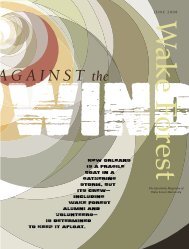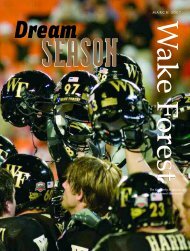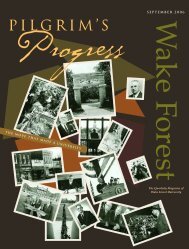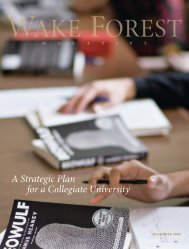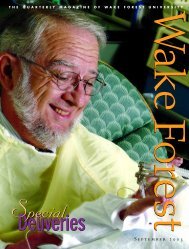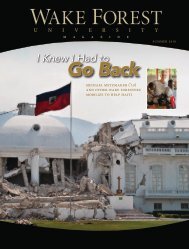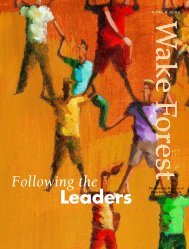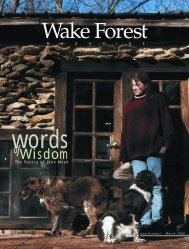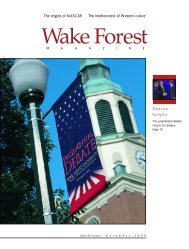Wake Forest Magazine, June 2009 - Past Issues - Wake Forest ...
Wake Forest Magazine, June 2009 - Past Issues - Wake Forest ...
Wake Forest Magazine, June 2009 - Past Issues - Wake Forest ...
Create successful ePaper yourself
Turn your PDF publications into a flip-book with our unique Google optimized e-Paper software.
The incomparable<br />
Jesse Haddock<br />
Legendary golf coach created<br />
a <strong>Wake</strong> <strong>Forest</strong> dynasty<br />
By Bill F. Hensley (’50)<br />
Jesse Haddock never dreamed he would become a<br />
coach when he enrolled at <strong>Wake</strong> <strong>Forest</strong> in 1944. The<br />
freshman from rural Winterville, N.C., had lofty thoughts<br />
of becoming a country doctor until he tackled a science<br />
course and didn’t fare too well. “I knew then,” he said,<br />
“that I better focus on something in business or athletics.”<br />
Haddock (’52) went on to become the most successful<br />
coach in <strong>Wake</strong> <strong>Forest</strong> history. In a sensational 30-year<br />
career from 1962 to 1992, he led the golf team to three<br />
national championships (1974, 1975 and 1986) and 15<br />
Atlantic Coast Conference titles. The Deacons won 10<br />
conference crowns in a row from 1967 to 1976, and<br />
finished second in the NCAA tourney three times. His<br />
1975 squad, which won the NCAA crown by 33 strokes,<br />
the largest margin in NCAA history, has been called the<br />
“best college golf team ever” by Golf World magazine.<br />
A number of his stars went on to outstanding careers on<br />
the PGA tour, including Curtis Strange (’77),<br />
Lanny Wadkins (’72, P ’96, P ’10), Jay Haas (’76, P ’04,<br />
P ’10), Jerry Haas (’85), Scott Hoch (’78), Gary Hallberg<br />
(’80), Jay Sigel (’67, P ’95, P ’99), Billy Andrade (’87), Jim<br />
Simons (’72, P ’99), and Len Mattiace (’90). Sixty-three<br />
Deacons made All-America during his tenure.<br />
Haddock first enrolled at <strong>Wake</strong> <strong>Forest</strong> in 1944 but was<br />
drafted by the U.S. Army after a year. He returned in 1947<br />
and received a degree in business in 1952. As a student, he<br />
performed a variety of chores in the athletic department<br />
and quickly caught the eye of Athletic Director James<br />
H. Weaver. He became Weaver’s assistant following his<br />
graduation.<br />
When alumnus Bill Gibson (’29, MA ’42) became AD<br />
in the early ’60s, he asked Haddock to take over as golf<br />
coach, thus creating the beginning of a dynasty that ranks<br />
with the most successful in college athletics. He won his<br />
first ACC championship a year later.<br />
He made recruiting his main priority and sought<br />
only the nation’s best, sometimes disregarding the<br />
recommendations of an avid alumnus or two pushing a<br />
hometown kid. And he concentrated on establishing a<br />
program that would help even the best players further<br />
develop their skills. He demanded that classwork — and<br />
teamwork — come first, and he politely showed the door<br />
to any player that didn’t conform, including observing his<br />
strong disciplinary policy.<br />
“I was honest with my players,” Haddock said, “and<br />
I expected them to be honest with me. Anything else was<br />
not acceptable. As a student, I had learned a lot working<br />
with coaches Peahead Walker and Murray Greason, and<br />
I wanted to adopt some of their philosophies.”<br />
Tim Straub (’89), a former Deacon All-America and<br />
star of the last national championship team, is the<br />
golf coach at Davidson College. “Coach was a sports<br />
psychologist before that term was popular,” he remarked.<br />
“He knew which players responded to a pat on the back<br />
and the ones who needed a kick in the rear. We always<br />
knew where we stood with him and what he expected<br />
of us.”<br />
Bill Stines (’84) was a walk-on to the golf team and<br />
is now golf director at the famed Scioto Country Club<br />
in Columbus, Ohio. “Coach Haddock understood golf,<br />
psychology, motivation and communication. He was<br />
ahead of his time in understanding the mental side of<br />
the game, and he pushed players to accomplishments<br />
they may never have been able to obtain otherwise.”<br />
Haddock and his wife, Kay, split their time between<br />
Winston-Salem and Linville, N.C. He still follows <strong>Wake</strong><br />
<strong>Forest</strong> athletics, but does he miss coaching? “I don’t miss<br />
the day-to-day grind, but I do miss the close association<br />
with the players. It was heartwarming to see them<br />
improve and become tough competitors, because<br />
I knew they would also do that in life.”<br />
Bill Hensley (’50) is a retired sports writer and a former<br />
director of sports information at <strong>Wake</strong> <strong>Forest</strong>.<br />
www.wfu.edu/alumni june <strong>2009</strong> 39




